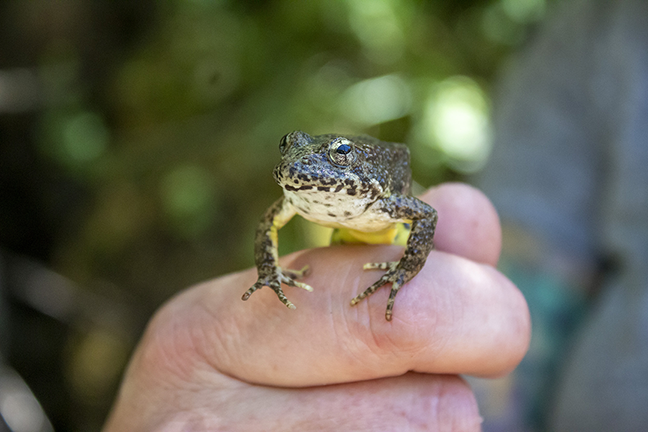U.S. Fish & Wildlife seeks public comment on proposed Endangered Species Act protections for Foothill yellow-legged frog

Juvenile Foothill yellow-legged frogs look similar to adults except for their smaller size, more contrasting dorsal coloration and lack of significant yellow on their undersurfaces. Credit: Rebecca Fabbri, USFWS
Four of the Six Distinct Population Segments of the Frog Warrant Protection; comment period Dec. 27, 2021 – February 28, 2022
In response to a Center for Biological Diversity petition and lawsuit, the U.S. Fish and Wildlife Service is proposing Endangered Species Act (ESA) protections for four geographically and genetically distinct population segments (DPS) of the Foothill yellow-legged frog.
“At last, these little lemon-legged frogs, who are such an integral part of our natural stream ecosystems, have gotten the protection they need to survive,” said Jeff Miller, a senior conservation advocate at the Center. “Protecting these precious creatures will also help safeguard the coastal and Sierra foothill rivers and creeks we all rely on for clean drinking water and recreation.”
The Foothill yellow-legged frog, named for its yellow belly and underside of its rear legs, is found from the Willamette Valley in Oregon to the Santa Lucia mountain range in southern California and from the Pacific coast to the western slopes of the Cascade and Sierra Nevada mountains. The amphibian faces several threats, including altered waterflows related to water infrastructure; competition with and predation by non-native species; disease; precipitation and temperature changes related to climate change; high-severity wildfires; water-related recreation; and habitat conversion and degradation.
“We closely examined the condition of each DPS and the threats they face. Using the best available science, we determined which populations warranted protections under the ESA and where future recovery efforts should be focused,” said Michael Fris, field supervisor of the Service’s Sacramento Fish and Wildlife Office.
To assess the condition of each DPS, the Service evaluated data collected on the frog’s occupancy of streams in its historical range. The Service is proposing to list the South Coast DPS and South Sierra DPS as endangered due to a strong pattern of declining stream occupancy, as well as rapid reductions in occupied range. The North Feather DPS and Central Coast DPS are proposed to be listed as threatened due to decreasing levels of stream occupancy and the potential for a variety of threats to cause additional declines. The North Coast DPS and North Sierra DPS are not warranted for listing after the data showed high levels of occupancy in streams located throughout their ranges, making them more resilient to environmental changes and catastrophic events.
“Our goal is to help the foothill yellow-legged frog recover across its range,” said Fris. “Ongoing collaboration with a number of partners will result in positive conservation gains and put this frog on the road to recovery.”
The Service is working closely with partners at the Oakland Zoo, U.S. Forest Service, Garcia and Associates, Pacific Gas and Electric and California Department of Fish and Wildlife to raise foothill yellow-legged frogs in captivity and release them into Plumas National Forest. The first group of captive-reared frogs, 115 in total, was released in July 2020. A second group of 36 was released in April 2021.
A copy of the finding will publish in the Federal Register on December 28, 2021, and is available for public inspection now. The Service plans to develop and propose critical habitat at a later date. The public can submit comments on the proposed listing and read supporting information at www.regulations.gov by searching Docket Number FWS–R8–ES–2021–0108. Comments should be submitted by February 28, 2022.
About USFWS
The U.S. Fish and Wildlife Service works with others to conserve, protect, and enhance fish, wildlife, plants, and their habitats for the continuing benefit of the American people. For more information about our work and the people who make it happen, visit the Sacramento Fish and Wildlife Office website. Connect with us via Facebook, Twitter, YouTube, and Flickr.
The mission of the U.S. Fish and Wildlife Service is working with others to conserve, protect, and enhance fish, wildlife, plants, and their habitats for the continuing benefit of the American people. We are both a leader and trusted partner in fish and wildlife conservation, known for our scientific excellence, stewardship of lands and natural resources, dedicated professionals, and commitment to public service. For more information on our work and the people who make it happen, visit www.fws.gov.
For more information on our work and the people who make it happen, visit http://www.fws.gov/. Connect with our Facebook page, follow our tweets, watch our YouTube Channel and download photos from our Flickr page.
Meghan Snow, Public Affairs Officer, U.S. Fish and Wildlife Service – Sacramento Fish and Wildlife Office and Herald Publisher Allen Payton contributed to this report.
the attachments to this post:

Juvenile Foothill yellow-legged frog USF&WS




















